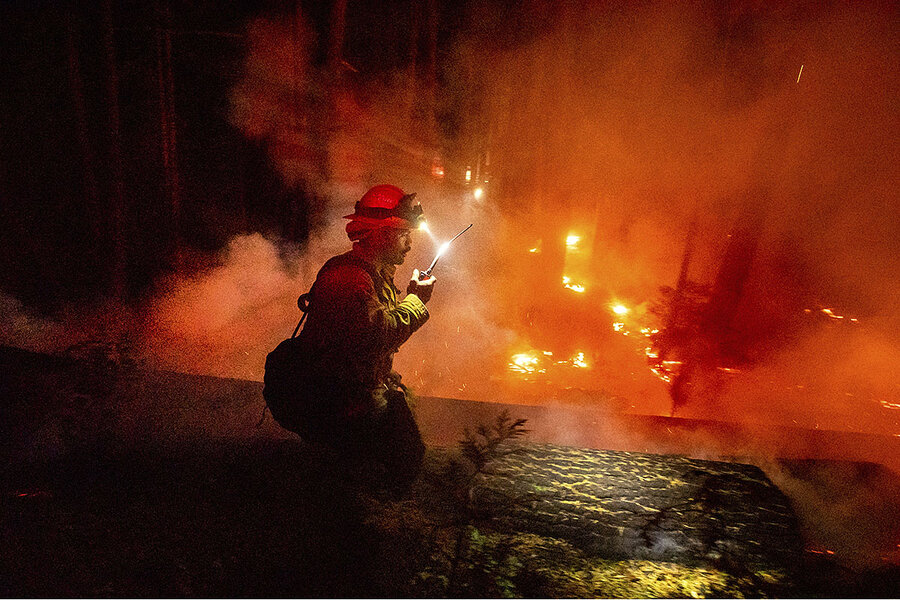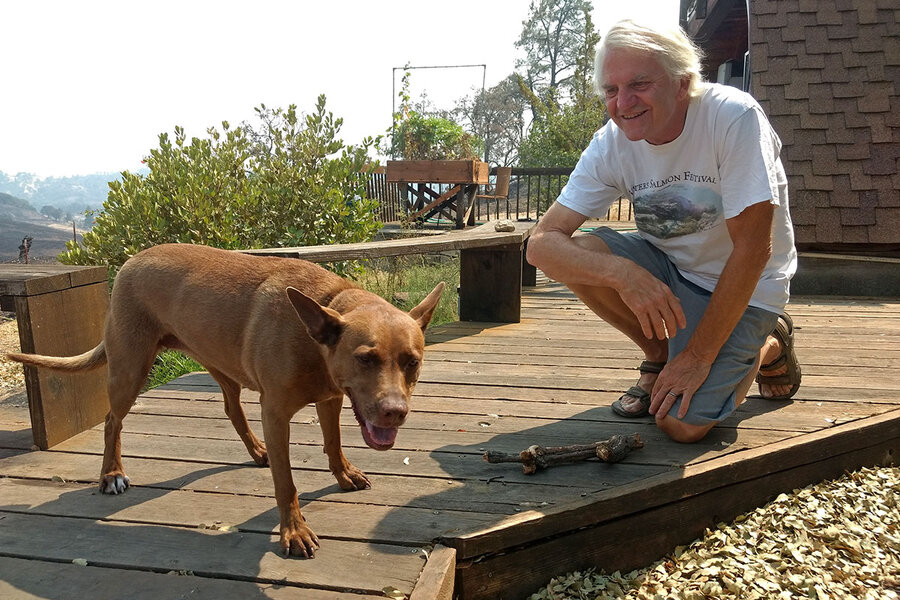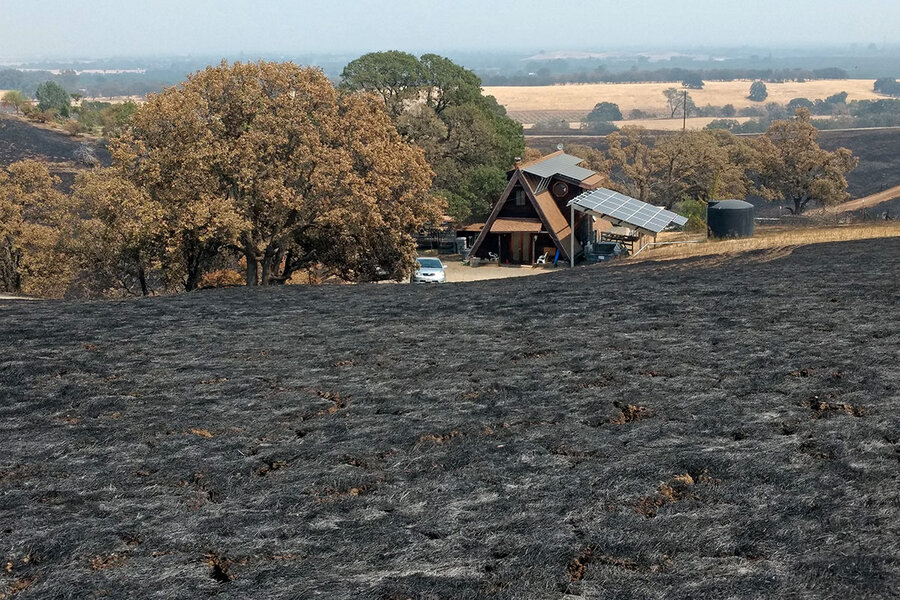‘Advance warning is the key’: California works to save most vulnerable
Loading...
| Winters, Calif.
In Winters, California, acrid smoke seeped into Cynthia Rodriguez’s home. The haze unsettled her adult daughter, Libby, who was born deaf and diagnosed with Down syndrome. Ms. Rodriguez and her husband searched news sites and called 911 as they tried in vain to learn details about nearby fires.
Then she received a call from a caseworker with the Yolo County health services agency alerting them that the county had ordered their area to evacuate an hour earlier.
Why We Wrote This
Time is of the essence when escaping wildfires. After some troubling failures, California is trying to find ways to protect older people and those with disabilities, such as including them in emergency planning.
“That’s not an ideal way to find out,” says Ms. Rodriguez, a retired attorney.
Amid wildfires that have burned a record 2 million acres, such failures pose particular risk for older residents and others who may require more time to escape. California law mandates that cities and counties include members of vulnerable groups in emergency planning.
“What’s happened historically with disaster preparedness is you have good people trying to do good things, but they operate from a somewhat limited perspective,” says Vance Taylor, who heads the office of access and functional needs for the state’s emergency services, and uses a wheelchair. “When you bring people with access and functional needs into the discussion, the reaction shifts from ‘your plan left us out’ to ‘our plan has some gaps – let’s fix them.’”
Ken Britten and Sandra Aamodt followed a familiar routine after learning about a wildfire burning four miles from their Northern California home. As with past fires in the parched hills outside the rural town of Winters, west of Sacramento, he scanned weather and news websites as she tracked social media for more details. The couple found little information that evening, yet while concerned, they judged the threat relatively low given their distance from the blaze and the lack of wind.
Around midnight, two hours after they went to bed, their pit bull mix, Tierra, began to stir. Mr. Britten, a retired neurobiology professor, stood up to let her outside the darkened A-frame house he bought in 1997. Opening the front door, he realized the dog’s anxious behavior had served as a warning – much of the night sky now glowed a furious orange.
He rushed up a slope on the eight-acre property and saw flames advancing down a hillside about a mile away. A stiff wind had kicked up, and the roaring inferno sounded to him like an enormous blast furnace. He hurried back to the house to rouse his wife. “We’re going,” he said.
Why We Wrote This
Time is of the essence when escaping wildfires. After some troubling failures, California is trying to find ways to protect older people and those with disabilities, such as including them in emergency planning.
A steep, sinuous gravel road links their neighborhood’s 10 large-lot homes, and residents – most of them middle-aged or seniors, some with functional needs – stay connected during emergencies through a group text thread. That night, Aug. 19, the thread blinked to life as neighbors alerted each other, the fifth time in six years that wildfire has forced them to evacuate.
The texts proved vital, possibly life-saving. A technical glitch in the emergency alert system for Yolo County prevented automated evacuation calls from reaching residents in imperiled areas, including the Winters neighborhood where Mr. Britten and Ms. Aamodt live. The county further waited until almost 4 a.m. to send evacuation texts and emails to residents, more than three hours after the couple fled the approaching fire.
The counties of Napa and Solano, both adjacent to Yolo, and several others endured similar emergency alert problems after dry-lightning strikes ignited hundreds of fast-moving wildfires in mid-August.
The failures and delays pose particular risk for elderly residents and people with access and functional needs who may require more time to escape. In the past month – with the eruption of the second-, third-, and fourth-largest wildfires in state history – pressure has intensified on public agencies to improve crisis planning for and evacuation of California’s most vulnerable residents.
“We have a lot of work to do,” says Don Saylor, a member of the Yolo County Board of Supervisors, who has pushed the county to fortify its disaster preparedness. “The bottom line is, we need to be far more attentive to the needs of seniors, people with limited mobility, or those who might live alone.”
Unreliable warning systems and erratic cooperation between California’s 58 counties have hampered swift evacuation of residents as the state confronts the dawning era of megafires. The infernos that flared last month and new fires that sparked over Labor Day weekend amid a withering heat wave have destroyed in excess of 3,300 homes and other structures, forced at least 120,000 people to evacuate, and claimed eight lives. In one dramatic nighttime rescue, helicopter crews airlifted more than 200 people trapped by a fire that exploded in forestland northeast of Fresno.
Tierra’s early warning enabled Mr. Britten and Ms. Aamodt to load up their two vehicles with essential possessions – laptops, documents, two cats – and for Mr. Britten to switch on a gas-powered sprinkler system connected to a 2,500-gallon water tank. Sometime after they drove to safety, the flames died in the wet grass within a few feet of the A-frame, sparing it the fate of three nearby homes that burned to the ground.
“If not for the dog, we might’ve lost the house,” says Mr. Britten, who installed the sprinklers and tank after a wildfire in 2016. He stood on his wooden deck looking down at hills charred the color of coal. “Who knows, we might’ve lost our lives.”
No silver bullet
A state audit last year examined the evacuation readiness and response of three counties ravaged by recent wildfires. The report concluded that deep deficiencies persist at the local and state level in aiding seniors, people with disabilities, and non-English speakers before, during, and after natural disasters. Counties neglected to identify vulnerable residents as part of emergency planning, assess the extra assistance they might require to evacuate, or devote sufficient resources to provide them with transportation and shelter.
The state’s review emphasized the inordinate impact of natural disasters on elderly residents. Two years ago in the Sierra Nevada foothills of Butte County, California’s deadliest wildfire on record killed 85 people in and around the town of Paradise, where some neighborhoods never received evacuation orders. More than three-fourths of the victims were age 65 or older.
Elder care advocates regard the missteps of counties this summer as worrisome evidence that vulnerable residents remain an afterthought in crisis preparations. “Is California getting better with each disaster? Yes. We’re learning from our mistakes,” says Debbie Toth, president and CEO of Choice in Aging. The Bay Area nonprofit group offers supportive services to seniors to help them preserve their independence. “But are we fully prepared? No. Not even close.”
The graying of California will accelerate over the next decade as the seniors population climbs from 5.8 million to an estimated 8.6 million by 2030, with more than 1 million requiring support to live at home.
The expanding cohort will age in a state beset by an increase in the number, magnitude, and severity of wildfires arising from climate change, overgrown forests, and sprawling development. As massive “fire clouds” obscure the sun and nearly 15,000 firefighters battle the flames, more than 2.2 million acres have burned already this year, eclipsing California’s single-year record of 1.85 million in 2018.
Democratic state Sen. Bill Dodd represents a district north of San Francisco that stretches across all or part of Napa, Solano, Sonoma, and Yolo counties. He joined emergency officials last month to tour areas scorched by fires, and they described the frantic door-to-door efforts of first responders to warn residents as ferocious winds propelled flames into neighborhoods. Faulty disaster alert systems compounded the chaos.
“They were successful in getting people out,” he says. “But that also underscored that the loss of life could have been far higher.”
The state audit found that the prevailing “opt-in” model for notification networks has excluded as many as 40% of a county’s residents from receiving evacuation calls, texts, and emails. Even if seniors sign up, a lack of tech literacy, a bout of confusion, or physical or cognitive impairment can leave them susceptible to impending danger.
California lawmakers approved a measure last week that authorizes use of two-tone, “high-low” sirens common in Europe on emergency vehicles, giving public safety agencies another method for reaching residents during natural disasters.
“None of these things is the silver bullet,” says Senator Dodd, who authored the bill. “But we have a lot of seniors and people with disabilities living on their own, and we have to make them aware every way we can.”
In the early hours of Aug. 19, a wildfire ripped through Vacaville, a city of 100,000 people in his district. Around 1:45 a.m., Ailene Klotz, a retired high school teacher, received an automated call from Solano County informing her of an evacuation advisory. She flipped on the lights in the ranch-style house where she has lived alone since her husband died 20 years ago and began to gather medications, clothes, jewelry, and photo albums.
A second call at 2:30 a.m. delivered an evacuation order. Ms. Klotz, who is 81, steered her Prius through smoke-choked darkness as she and her shih tzu, Molly, fled to a nearby seniors center converted into a temporary emergency shelter.
Her house survived unscathed, unlike hundreds of others in the area, and she recognizes her good fortune – and the complicated decision that emergency officials faced on sending alerts as winds shifted and swirled. Still, after so many destructive infernos in California the past three years, she suggests that counties notify residents sooner rather than later.
“Forty-five minutes isn’t enough time,” she says. “The alerts have to be earlier and faster because the fires are getting worse. At this age, you want as much warning as you can get.”
The key to survival
The same morning, 15 miles away in Winters, acrid smoke seeped into Cynthia Rodriguez’s home. The haze unsettled her adult daughter, Libby, who was born deaf and diagnosed with Down syndrome. Ms. Rodriguez and her husband searched news sites, watched TV, and called 911 as they tried in vain to learn details about nearby fires.
As they weighed whether to leave, she received a call at 10:30 a.m. from a caseworker with the Yolo County health services agency that assists with Libby’s care. The person told her the agency was alerting clients in the couple’s neighborhood that the county had ordered an evacuation of their area an hour earlier.
“That’s not an ideal way to find out,” says Ms. Rodriguez, a retired attorney, whose son drove to Winters to pick up Libby and bring her to his home near Oakland.
“We have to exercise judgment not just for ourselves but those we’re caring for,” she says. Packing adaptive equipment or loading a person with disabilities into a vehicle can slow an individual’s or family’s escape, as appears to have occurred with an older couple who lived outside Winters and died in the fires.
“Advance warning is the key to survival,” Ms. Rodriguez adds. “You need time to plan and gather your resources and your energy so you can get out the door.”
State law mandates that cities and counties take into account people with access and functional needs as part of emergency readiness – a directive that covers alerts, evacuations, and post-disaster shelter – and to include members of vulnerable groups in the planning process.
Last year’s audit of evacuation practices criticized county agencies for failing to fulfill either obligation, and faulted California’s office of emergency services for dedicating inadequate resources and guidance to counties to aid vulnerable residents. Vance Taylor, who heads the office of access and functional needs within that state agency, advocates a broader, more collaborative approach at the county level to strengthen the emergency net.
“What’s happened historically with disaster preparedness is you have good people trying to do good things, but they operate from a somewhat limited perspective,” Mr. Taylor says. He was diagnosed with muscular dystrophy as a child and uses a wheelchair. “When you bring people with access and functional needs into the discussion, the reaction shifts from ‘Your plan left us out’ to ‘Our plan has some gaps – let’s fix them.’”
Kate Laddish lives in Winters and belongs to an advisory committee on disaster readiness that last week presented a slate of recommendations to the county board of supervisors. The committee called for a thorough census of residents with access and functional needs and sending more alerts during emergencies to help them better prepare for a potential evacuation.
When flames reached the outskirts of Winters three weeks ago, Ms. Laddish, in the absence of county updates, listened to scanner apps tuned to fire and police channels. She found herself fielding calls and texts from other residents in the city seeking information that night.
“When you don’t get any notifications but you know there’s a fire,” she says, “you’re left wondering if you’re not under an evacuation order or the system failed or something else.”
Ms. Laddish, a former geology professor and park ranger whose diagnoses of muscular and neurological disorders qualify her for disability assistance, lives in an affordable housing complex for seniors and people with functional needs. During those fraught hours, she feared what might happen to vulnerable residents like those in her building if the high winds brought the fire barreling into town.
“Without getting enough notice to evacuate,” she says, “there would have been catastrophic loss of life.” She contends that the county relies too much on neighbors helping each other when disasters hit. “Fantastic community spirit isn’t an evacuation plan.”
Gov. Gavin Newsom launched an initiative last year called Listos California – Spanish for “ready” – that has funneled $50 million to nonprofit and community groups statewide to promote disaster preparedness among seniors, people with functional needs, non-English speakers, and low-income residents. The program holds emergency training sessions, distributes “go kits,” and works with vulnerable populations to create evacuation plans.
The campaign also urges people to sign up for county and state disaster alerts. Emergency officials in Yolo County, following the failure of the automated call system, fixed the technical snafu and tested the network last week. The good results encouraged Mr. Saylor, the board supervisor, who wants Yolo to emulate nearby counties that send more warnings to residents.
“We’re past the time when we can withhold giving notice because some people might be annoyed about receiving too many alerts,” he says. “The risks of not notifying are too great. Fires are still burning.”










